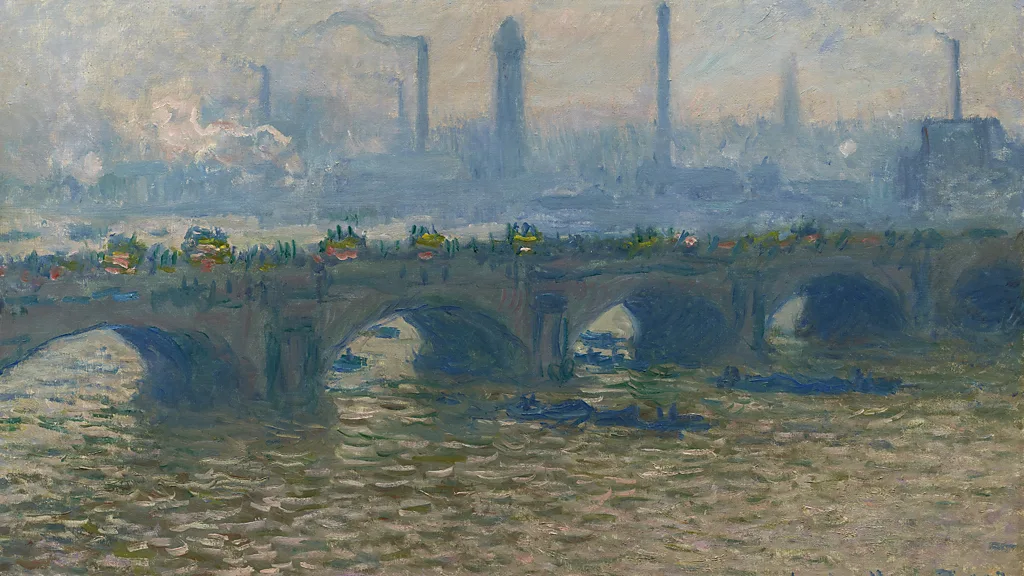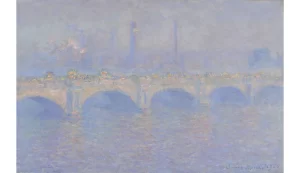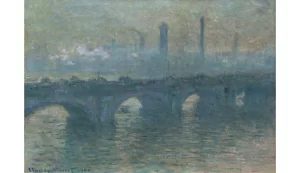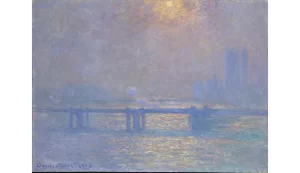
A new exhibition titled Monet and London: Views of the Thames at the Courtauld Institute explores how Claude Monet’s fog-drenched interpretations of the Thames profoundly changed London’s self-image. Between 1899 and 1901, Monet embarked on a remarkable journey that resulted in nearly 100 paintings of the city, more than any other subject in his extensive career.
Monet’s approach transcended mere representation; he delved into the interplay of light and atmosphere, presenting a view of London that was both ethereal and haunting. His works capture the river shrouded in a murky veil of smog, transforming the solid structures of the city into shimmering, ephemeral forms. As T.S. Eliot later described, Monet’s London became an “unreal city,” an otherworldly space that exists outside of time.
One of the standout pieces from this series is London, The Houses of Parliament, Shaft of Sunlight in the Fog. This painting depicts the Palace of Westminster’s intricate turrets emerging from a swirling fog, illuminated by fleeting rays of afternoon light. During his second visit to London in 1901, Monet painted from the terrace of St Thomas’s Hospital, capturing the Houses of Parliament in various atmospheric conditions. His earlier work from the Savoy Hotel balcony focused on Waterloo Bridge, where the changing light transformed the imposing structure into a spectacle of glowing forms.

While Monet is often lauded for his masterful representation of light, the uniqueness of his work lies in his exploration of how sunlight interacts with the air. His paintings reveal a world that is fluid and transient, where form is less defined and more malleable. Monet believed that the essence of the city was best expressed through its interactions with light and fog, leading him to create a new visual language for understanding reality.
The transformative nature of Monet’s art was recognized even during his time. A US collector and writer, Desmond FitzGerald, noted the intriguing optical illusions in Monet’s work, which often left viewers bewildered by the hazy interplay of substance and air. The way London’s urban landscapes shimmered in a veil of fog was unprecedented, revealing a beauty previously overlooked.

Monet himself understood that fog was crucial to his artistic vision. He famously stated, “Without the fog, London wouldn’t be a beautiful city.” The fog provided a grandiosity to the city’s architecture, enhancing its allure. When he encountered a clear morning, he expressed dismay, fearing his paintings would suffer without the fog’s mystical touch. His relief when the mist returned underscored the idea that the atmospheric qualities of London were fundamental to his artistic expression.
This artistic exploration coincided with significant developments in the field of physics. Around the same time Monet was capturing the nuances of light on canvas, Max Planck was theorizing about light as packets of energy. Monet’s focus on light and its effects mirrored the scientific inquiries of his era, highlighting a cultural moment where the nature of light was being redefined both in art and science.

Oscar Wilde, writing in the same period, suggested that our perception of fog in London was shaped by artists like Monet, stating, “Things are because we see them, and what we see, and how we see it, depends on the Arts that have influenced us.” This sentiment speaks to the transformative power of art; Monet’s interpretation of the Thames made fog an integral part of the city’s identity, rather than a mere weather condition.
Comparing Monet’s work with that of his British predecessor J.M.W. Turner reveals a striking contrast in vision. While Turner’s portrayal of the Thames often highlights the negative impacts of industrialization, Monet embraced the fog as a dynamic element that infused the city with beauty and intrigue. In Turner’s The Thames Above Waterloo Bridge, smoke is a blight, while in Monet’s Waterloo Bridge, Sunlight Effect, it becomes a vibrant aspect of the atmosphere.

Monet’s London series is not merely about capturing fleeting moments; it reflects an intricate amalgamation of experiences. His working process involved creating numerous studies that he would continuously refine, each canvas a layered exploration of light and shadow. Back in Giverny, he spent four years revising these paintings to achieve a harmony that could resonate like a symphony.
The Monet and London exhibition presents a rare opportunity to engage with over a third of the works from this groundbreaking series. It serves as a testament to how Monet’s unique vision not only altered perceptions of the Thames but also transformed the way we see and understand urban landscapes. Visitors will find themselves immersed in a convergence of artistic wonder that may never occur again, allowing them to appreciate the delicate interplay of light, fog, and architecture that defines Monet’s London.
The exhibition runs until January 19, 2025, at the Courtauld Gallery in London.





